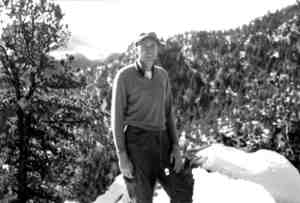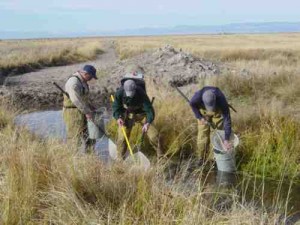Article by Allen Best
Wolf Creek Development – May 2007 – Colorado Central Magazine
YOU WANT ABSURDITIES? The story about real estate development at Wolf Creek Pass has them in spades. It has so much weirdness that if John Nichols just changed the names and threw in some Spanish, his New Mexico trilogy would become a quatrology. The facts of this case read like fiction. All it lacks is a chase scene and a geezer named Amarante.

Granted, the story is about a land development next to a ski area, which isn’t exactly the most novel plot line. In mountainous Colorado, one good rule of thumb is that the highest priced real estate is closest to the ski lifts. Another rule is that the higher the location, the pricier the land.
Given that logic, this proposal for 2,200 housing units at an elevation of 10,300 feet next to the Wolf Creek Ski Area — one of the few ski areas in Colorado that still calls itself a ski area, not a resort — should produce more gold than was ever hauled out of the San Juan Mountains. Yet for every gold strike there was at least one empty hole in the ground. That, as much as potential success, is the fear in this case. Even if you rather like the wave of alpine “villages” being installed across the Rocky Mountains, this is just a rotten place for real estate development.
So far, the Village at Wolf Creek has been nothing but an empty hole for pouring money down. B.J. “Red” McCombs is the money-bags in this story. He’s a self-described Bubba and law-school dropout from Texas who had his first car dealership at 25 on his way to a car-dealership empire, then helped himself to additional fortunes in media, oil and gas, and real estate development, plus a string of professional basketball, baseball and football teams, most recently the Minnesota Vikings.
The 2006 Forbes tally estimated his worth at $1.3 billion. He long ago gave up drinking, has been married to the same woman for 57 years, and gives handsomely to charity. And in the early 1980s, when ski areas were still riding the demographic bulge of baby boomers in annual double-digit growth, McCombs was persuaded by a fellow Texan to get involved with this itty-bitty ski area. “We’ll do a land exchange with the Forest Service and build condos at the base of the ski area,” the fellow Texan, who requires no mention here, might have said.
The Texans did so with the complicity of the ski area, a private enterprise located on federal land. It was then owned and managed by Kingsbury Pitcher. Few white people have deeper roots in the San Juan Mountains than Pitcher. His grandfather, Otto Mears, arrived at Saguache in 1866, grew wheat, then supervised construction of a rhizomic network of roads and railroad lines to service the mining industry of the San Juans. Kingsbury, in keeping with the theme of his times, got involved in recreation during the 1950s in Aspen. Aspen then was like an exploding flower, spewing seedlings everywhere. The seeds of Kinsgbury Pitcher landed at Ruidoso, New Mexico, where he developed Ski Apache, and at Wolf Creek Pass, one of the few San Juan crossings that Grandpa Mears had not conquered.
IN TIME, THOUGH, Wolf Creek had a highway, and even before World War II, primitive rope tows were assembled by ranchers from the San Luis Valley. The modern era can be dated to the first chairlift in 1972-73, when plans were also submitted to the Forest Service for a major ski resort able to accommodate 8,000 skiers a day — a large resort, even by today’s standards. Pitcher bought the ski area in 1976, and it remains in the family now, operated principally by his son, Davey, 44. Kingsbury, who is now well into his 80s, lives in Santa Fé.
Clearly, the Texans had some sort of deal with the Coloradans. The broader story would seem to be that Kingsbury Pitcher figured a growing business would eventually need base-area lodging, as was found at other destination ski resorts. So, in 1986, the Pitcher family endorsed a land swap: 1,600 acres of inholdings located elsewhere went to the Forest Service, and McCombs got 286 acres of public land next to the ski lifts. Land swaps then were rarely controversial, and neither was this one. Still, the district ranger in Del Norte initially rejected it, but was overruled two weeks later by superiors in Washington D.C. It wasn’t the first time the top brass in Washington have been involved.
At that point, a detailed proposal for 2,400 housing units at the base area — later pared to 2,200 units — was submitted to officials in Mineral County, where the ski area is located. Again, this came with the apparent endorsement of the Pitchers. But why Mineral County has any say-so over this matter is one of those curiosities — some would say misfortunes — of straight-line political boundaries imposed on Colorado’s ragged geography.
[Davie Pitcher, the hands-on CEO at Wolf Creek]
Colorado county boundaries often conflict with geographic barriers. Consider the town of Marble. It’s just 45 minutes to Glenwood Springs, the county seat for Garfield County. Yet Marble is in Gunnison County, and thus relies on a courthouse three hours away during snow season, and close to two hours away when the snow has melted. Can there be any sharper rebuke to the watershed thinking of John Wesley Powell?
YES, THERE IS, and it’s in the San Juan Mountains. Hinsdale County may well be the most ill-advised chunk of governance ever created. Originally designated to accommodate the mineral wealth being exploited around Lake City, it sprawls across the Continental Divide and encompasses the San Juan, Rio Grande and Gunnison river drainages. When the wondrous wealth of Creede was discovered, some of this abstraction was sliced off again in straight-line fashion — with the map rather than access in mind — to create Mineral County.
The consequence of this linear thinking is that to get from the Mineral County Courthouse in Creede to Wolf Creek Pass you must leave the county. To get to some parts of Mineral County by road sometimes involves driving past two other courthouses. Blame it on dead white men, says John Wilder, the Mineral County attorney for the last 30 years. “There’s no question that when the county lines were drawn, there were, I guess you’d say, a bunch of morons in the state legislature, because they (county lines) utterly ignore natural features that are huge — like the Continental Divide. It’s absolute madness to have a county split by the Continental Divide.”
Of course, plenty of people believe the vested property rights Mineral County awarded the Village at Wolf Creek in 2001 are utter madness. Even those who accept the gussifying up of the Colorado high country for both sport and commerce see this as a risky project or worse.
Consider that this potential city of 5,000 or more people is located at 10,300 feet in elevation, about the same as Leadville. But people in Leadville mostly live there full time. The Village at Wolf Creek is planned for mostly time-share residency, presumably of people arriving from low elevations. The closest comparable resort is Breckenridge, which has a base elevation of 9,600 feet. One study showed that 40 percent of visitors arriving at Breckenridge from sea level can expect to have a headache, poor appetite, and not sleep well for several nights.
This new city in the sky would also need infrastructure. There is no nearby energy supply. Instead, liquefied natural gas would be stored at the site and burned to generate electricity. Such things can be done — with enough money. Then there’s all the snow, on average, more than 400 inches of snow annually, which is tops among Colorado’s ski resorts (with the possible exception of Silverton Mountain). Of course, snow can be moved and melted -with enough money. And modern destination resorts need air access. The nearest airport of any consequence is at Durango, two hours west, although the Village at Wolf Creek is currently working to improve air access at Del Norte. Such things are possible — with enough money. East West Partners managing principal Harry Frampton, one of the major developers at Beaver Creek, Breckenridge, and Park City, believes the Village at Wolf Creek is doable, but will require “extraordinarily deep pockets.”
RED MCCOMBS has precisely such pockets. He is, according to Forbes, the 258th richest American. And he’s not afraid to donate it to good causes, mostly Republican ones, $524,000 altogether in recent years, according to federal election records. One of these money trails extends to Tom DeLay, the now disgraced congressman from Texas, who recommended Mark Rey, a former timber industry lobbyist, to be the Bush administration appointee to oversee the Forest Service. This matters only if you think — as Wolf Creek opponents do — that the Forest Service has been negligent in carrying out its oversight obligations.
So why does Mineral County think this real-estate project such a swell idea? The county commissioners are muzzled, because of litigation, but Wilder, the attorney, is not. Wolf Creek Pass, he insists, is not exactly wilderness. Nor is Mineral County thick with private land. Some 92 percent of property is administered by the federal government. “I don’t know why it’s so unthinkable that the county would approve the commercialization of the 300 acres,” he says.
Not everybody in Mineral County supports the project. Jim Turnbull, member of a group called Citizen for Responsible Development, said he believes the county commissioners think the project is needed as an economic stimulus of a depressed county. But Turnbull, a musician, disagrees. “The county isn’t that bad off, I know everybody in town, and people are employed and making a decent living.”
Turnbull also fears that Mineral County could end up holding the legal bag for a project gone bad. For those who do not trust Colorado governments to properly safeguard the high country, there are precedents aplenty, but none so blatant as the mining disaster at Summitville, located just a few miles away from Wolf Creek. Public costs for the toxic cleanup there have reached $200 million.
Nonetheless, opinions are mixed along Highway 160. Drummed up by the expert and steady fanning of flames by Colorado Wild, a relatively new player in the proceeds, opposition is close to religion in Pagosa Springs, which is likely to house service workers, and at Durango. On the east side of the pass, in South Fork, the fervor tilts in the other direction, although it thins out in the ranching and farming communities. “I would say the grassroots is against it, but the public officials have supported it,” says Chris Canaly, of the San Luis Valley Ecosystem Council.
Still unclear is exactly what religion the Pitcher family now has. If the Pitchers and the Texans were once in bed on this project, they have split the sheets and are now in a legal duel. The Pitchers, through a spokeswoman in Denver, Michelle Ames, insist they still support the base-area village, but only with “responsible development.” What constitutes responsible development, she didn’t say, but it would seem something far less than 2,200 housing units.
THE GREATER TRUTH in this collection of facts may be a couple of new characters that arrived on the scene in 1996. Red McCombs was tired of having his money tied up in a project that had gone nowhere, so he hired Bob Honts, a former county commissioner from Austin. Honts was to “make this dog hunt,” as they say in Texas. Honts comes across in newspaper accounts as a prototypical Texan, the kind of person about whom the Texas singer-songwriter Kinky Friedman once said, “Just my luck that God’s a Texan, one big son-of-a-bitchin’ Anglo-Saxon.” When I called seeking an interview, he quickly offered me a job as a public-relations writer but ultimately declined an interview because, he indicated, publications such as Colorado Central were too small to warrant his time.
Davey Pitcher, Kingsbury’s son, also arrived at Wolf Creek in 1996. He’s now the chief executive officer, but he spent his years after high school working construction, not in pursuit of a masters in business administration. He keeps a tool belt lying around his office, grooms the slopes himself, and on a rain-turning-to-snow Saturday in October when I interviewed him, was operating a hoist while trying to finish installation of a lift. He didn’t tell me much, and got testy when I asked an innocent question about the lawsuit filed by McCombs and Hont against his family. Others, who would know such things, say that Wolf Creek manages to make money, even if it is still old-fashioned and doesn’t have Kleenex in the lift lines. At stake in this contested real estate development is a way of life and — I am told — ultimately the ownership of the ski area.
How exactly the Texans might wrestle control of Wolf Creek from the Coloradans, I never understood. I am waiting to find out as soon as John Nichols sees the possibilities in this case, and wrings some truth out of the facts in his next novel.
Allen Best traverses the West from his base in Arvada.




